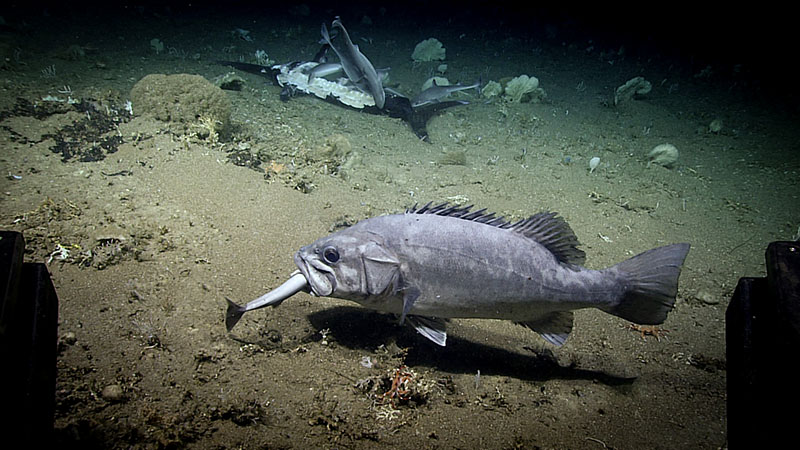Sharks Happen
July 22, 2020
Towards the end of the seventh dive of the Windows to the Deep 2019 expedition, after searching for a potential shipwreck target approximately 80 miles off the coast of South Carolina and instead finding a series of rocky outcrops, the expedition team had a rare encounter—a group of sharks in what looked to be a feeding frenzy appeared in the dim reaches of remotely operated vehicle Deep Discoverer's lights. Upon closer approach, the lights revealed a dead swordfish, approximately 2.5 meters (8 feet) in length, lying on the seafloor with at least 11 sharks circling and feeding “vigorously” on the swordfish's skin and muscle tissue. Video courtesy of the NOAA Office of Ocean Exploration and Research, Windows to the Deep 2019. Download larger version (mp4, 145.7 MB).
Exploration, whether on land, in space, or underwater, requires knowing what is new. That is, recognizing what we know and what we don't know. Just over a year ago, using remotely operated vehicle (ROV) Deep Discoverer (D2) and the telepresence capabilities of NOAA Ship Okeanos Explorer, researchers essentially "stumbled" upon a rare and incredible scene filled with deep-sea predators.
On June 28, 2019, as the ROV flew just above the seafloor at the base of a small “hill” at a depth of approximately 450 meters (1,485 feet) off the coast of South Carolina, the far edge of visibility illuminated by the vehicle lights revealed at least 11 deep-sea sharks—dogfish—in a feeding frenzy devouring the body of an 2.3-meter (7.6-foot) long Atlantic swordfish. Two species of deep-sea dogfish were observed in this primal scene, roughtail dogfish (Cirrhigaleus asper) and Genie’s dogfish (Squalus clarkae). The later species, described in 2018, is named to honor the famous shark biologist Dr. Eugenie Clark– the “Shark Lady” of the University of Maryland and Mote Marine Laboratory.

Remotely operated vehicle Deep Discoverer images the swordfish fall. Image courtesy of the NOAA Office of Ocean Exploration and Research, Windows to the Deep 2019. Download larger version (656 KB).
Large body animals that die and descend to the deep seafloor are termed “food falls.” The role that these food falls play is to transfer large amounts of organic carbon, derived from productivity in surface waters (e.g., phytoplankton to zooplankton, zooplankton to small fish, and so on through apex predators) in single large parcels. Finding such food falls is a rare event, unpredictable in space and time. Most well-studied natural food falls are those of whales, discovered in an ad hoc manner and then revisited by submersible vehicles over time. Experimental studies have used submersibles and time-lapse cameras with whales, reptiles, and fish placed at the seafloor and sampled to assess the diversity of species that benefit from the delivery of large volumes of organic carbon (food).

At least 11 dogfish sharks were observed feeding on this recently deceased Atlantic swordfish. Image courtesy of the NOAA Office of Ocean Exploration and Research, Windows to the Deep 2019. Download larger version (2.4 MB).
Finding this “fresh” swordfish was serendipitous, as at the rate of feeding by the sharks surely would have left little to see after 24 hours or so. The swordfish appears to have died of natural causes, with no evidence of fishing gear or other human-related causes. The swordfish appeared to be only hours old, based on the amount eaten by the sharks and the number of predators circling and feeding. While odor trails from food falls are generally considered to be the primary way that mobile animals find these sites, the sounds produced by the sharks feeding are hypothesized as a more immediate attractant to these predators that are normally widely dispersed but can swim rapidly to potential prey.
Equally novel was the observation of a wreckfish, a large deepwater predator, ambushing and consuming a small shark. While shark vertebrae have been found in the stomachs of wreckfish caught on hook and line, the assumption was they were eaten as discards from fishing activities. Here, the video demonstrated that at least some of the found vertebrae must come from actual predation.

This large wreckfish was seen consuming a small Genie’s dogfish—whole! Image courtesy of the NOAA Office of Ocean Exploration and Research, Windows to the Deep 2019. Download larger version (1.4 MB).
All of these observations inform us that there is much to learn about the types and scope of species interactions that occur beyond the continental slope and into the deep sea, especially for higher trophic level predators. We need to understand how life works in these remote places if we are to manage for conservation and sustainable use. Only then can we compare what has changed with what has stayed the same in this time of incredible environmental change.
Dr. Peter Auster and colleagues at Florida State University and the NOAA Office of Ocean Exploration and Research recently published a paper in the Journal of the Ocean Science Foundation, titled “Observations of deep-sea sharks and associated species at a large food fall on the continental margin off South Carolina.” To learn more about these unusual observations, read the full paper here .
Text contributed by Dr. Peter Auster, Mystic Aquarium and University of Connecticut.
Auster, Peter J., Cantwell, Kasey, Grubbs, R. Dean, & Hoy, Shannon. (2020). Observations of deep-sea sharks and associated species at a large food fall on the continental margin off South Carolina, USA (NW Atlantic). Journal of the Ocean Science Foundation, 35, 48–53.
http://doi.org/10.5281/zenodo.3932138